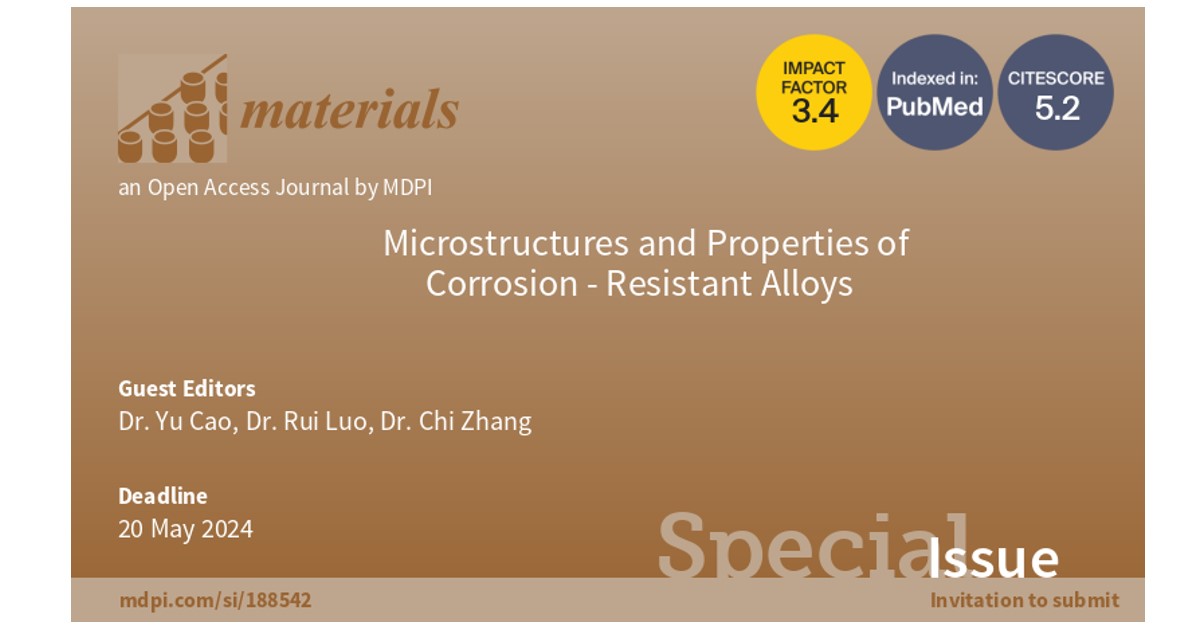Microstructures and Properties of Corrosion-Resistant Alloys
A special issue of Materials (ISSN 1996-1944). This special issue belongs to the section "Metals and Alloys".
Deadline for manuscript submissions: closed (20 November 2024) | Viewed by 2061

Special Issue Editors
Interests: corrosion-resistant alloy; plastic deformation behaviour; microstructure characterization; microstructure property
Interests: hot working; heat treatment; microstructure; mechanical properties; constitutive equation; superalloy
Interests: high-performance stainless steel; texture evolution; plastic processing; multi-scale modelling and simulation
Special Issues, Collections and Topics in MDPI journals
Special Issue Information
Dear Colleagues,
The aim of this Special Issue, “Microstructures and Properties of Corrosion-Resistant Alloys”, is to collect research on the latest developments in material properties and characterization, pure/applied corrosion, and the advanced understanding of thermo-mechanical processing. We also welcome papers about the heat treatment, modelling and simulation of alloys.
Authors are invited to present their research using novel approaches related to the properties and microstructures of metals and alloys that affect their mechanical properties, corrosion resistance and other properties.
We aim to publish original peer-reviewed papers in the field of corrosion, forming an important link between material scholars and scientists, as well as with all investigators of metallic materials for various demanding applications.
As Guest Editors, we kindly invite you to contribute both original articles and review works on this topic that deal with the characterization and corrosion resistance evaluation of metals and alloys.
Dr. Yu Cao
Dr. Rui Luo
Dr. Chi Zhang
Guest Editors
Manuscript Submission Information
Manuscripts should be submitted online at www.mdpi.com by registering and logging in to this website. Once you are registered, click here to go to the submission form. Manuscripts can be submitted until the deadline. All submissions that pass pre-check are peer-reviewed. Accepted papers will be published continuously in the journal (as soon as accepted) and will be listed together on the special issue website. Research articles, review articles as well as short communications are invited. For planned papers, a title and short abstract (about 100 words) can be sent to the Editorial Office for announcement on this website.
Submitted manuscripts should not have been published previously, nor be under consideration for publication elsewhere (except conference proceedings papers). All manuscripts are thoroughly refereed through a single-blind peer-review process. A guide for authors and other relevant information for submission of manuscripts is available on the Instructions for Authors page. Materials is an international peer-reviewed open access semimonthly journal published by MDPI.
Please visit the Instructions for Authors page before submitting a manuscript. The Article Processing Charge (APC) for publication in this open access journal is 2600 CHF (Swiss Francs). Submitted papers should be well formatted and use good English. Authors may use MDPI's English editing service prior to publication or during author revisions.
Keywords
- corrosion-resistant alloy
- microstructure characterization
- mechanical property
- thermo-mechanical processing
- heat treatment
- modelling and simulation
Benefits of Publishing in a Special Issue
- Ease of navigation: Grouping papers by topic helps scholars navigate broad scope journals more efficiently.
- Greater discoverability: Special Issues support the reach and impact of scientific research. Articles in Special Issues are more discoverable and cited more frequently.
- Expansion of research network: Special Issues facilitate connections among authors, fostering scientific collaborations.
- External promotion: Articles in Special Issues are often promoted through the journal's social media, increasing their visibility.
- e-Book format: Special Issues with more than 10 articles can be published as dedicated e-books, ensuring wide and rapid dissemination.
Further information on MDPI's Special Issue polices can be found here.








